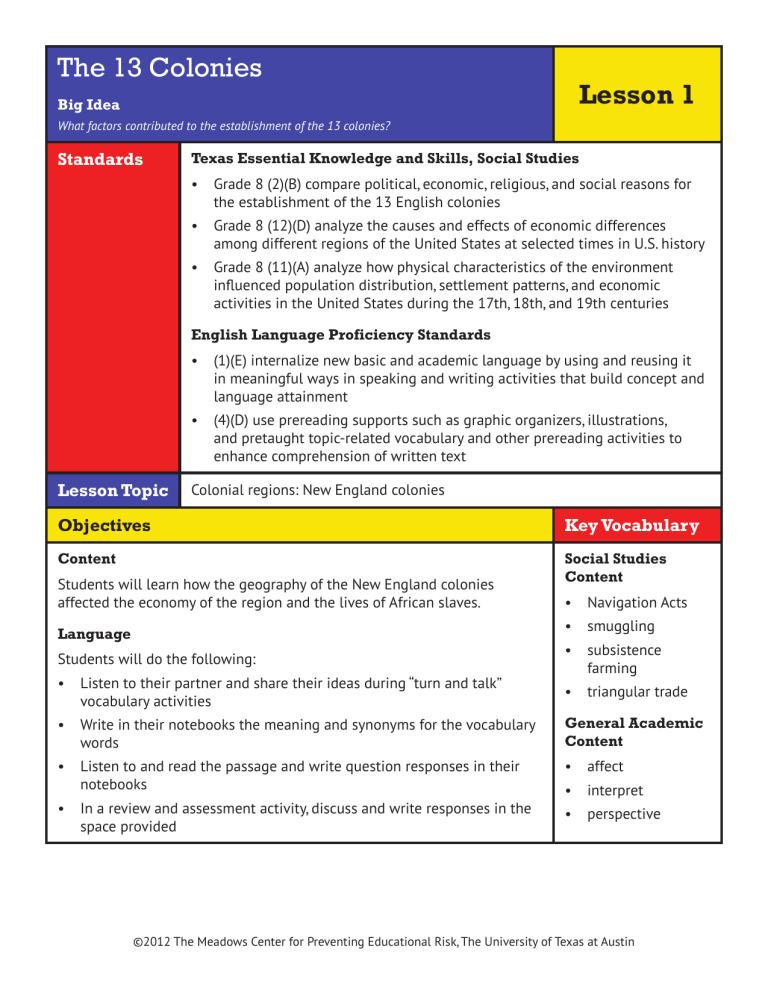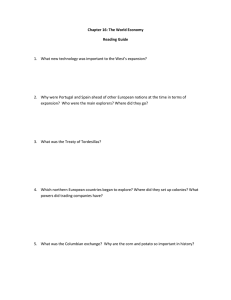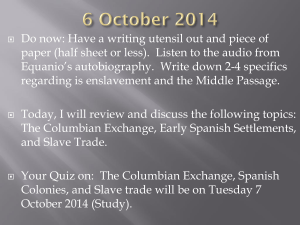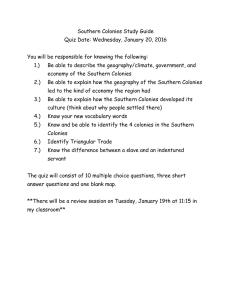handout age of exploration
advertisement

The 13 Colonies Big Idea Lesson 1 What factors contributed to the establishment of the 13 colonies? Standards Texas Essential Knowledge and Skills, Social Studies • Grade 8 (2)(B) compare political, economic, religious, and social reasons for the establishment of the 13 English colonies • Grade 8 (12)(D) analyze the causes and effects of economic differences among different regions of the United States at selected times in U.S. history • Grade 8 (11)(A) analyze how physical characteristics of the environment influenced population distribution, settlement patterns, and economic activities in the United States during the 17th, 18th, and 19th centuries English Language Proficiency Standards • (1)(E) internalize new basic and academic language by using and reusing it in meaningful ways in speaking and writing activities that build concept and language attainment • (4)(D) use prereading supports such as graphic organizers, illustrations, and pretaught topic-related vocabulary and other prereading activities to enhance comprehension of written text Lesson Topic Colonial regions: New England colonies Objectives Key Vocabulary Content Social Studies Content Students will learn how the geography of the New England colonies affected the economy of the region and the lives of African slaves. • Navigation Acts • smuggling Language Students will do the following: • Listen to their partner and share their ideas during “turn and talk” vocabulary activities • subsistence farming • triangular trade • Write in their notebooks the meaning and synonyms for the vocabulary words General Academic Content • Listen to and read the passage and write question responses in their notebooks • affect • In a review and assessment activity, discuss and write responses in the space provided • perspective • interpret ©2012 The Meadows Center for Preventing Educational Risk, The University of Texas at Austin The 13 Colonies, Lesson 1 Lesson Plan—2 Materials Preparation • Student notebooks • Computer station and document camera • Texts: • “Creating America: A History of the United States” • From the textbook: • “The Farms and Towns of New England” (p. 94; include map) • “Harvesting the Sea” (p. 95, paragraphs 1 and 4) • “Atlantic Trade” (pp. 95–96; include graphic) • Learning log handout • Vocabulary cards • Videos (from “America: The Story of Us”): • “13 Colonies” (1:32) www.youtube.com/watch?v=qiMCXWMvRJc • “Colonial Triangular Trade/Slave Trade” (1:26) www.youtube.com/watch?v=R1BYZRn4Lgc • Post the standards and objectives for this lesson. • Write the New England colonies on the board: Rhode Island, Massachusetts, Connecticut, and New Hampshire. Motivation (Engagement and Links) 5 minutes Provide an overview and background information for today’s lesson. As we have discussed in previous lessons, the English set up settlements in Jamestown, Virginia, and Plymouth, Massachusetts. At first, these settlements struggled to survive. Eventually, these settlements and others grew into the 13 colonies. Today, we will discuss how the geography of the New England colonies (Connecticut, Rhode Island, Massachusetts, and New Hampshire) affected the economy of the region. We will also learn how Atlantic triangular trade affected the lives of African slaves. Presentation Vocabulary 25 minutes (10 minutes) • Introduce today’s vocabulary and have students discuss the turn and talk items in pairs and/or with the whole group. • Have students write vocabulary terms and synonyms in their notebooks. Video (5 minutes) Introduce the videos: “13 Colonies” and “Colonial Triangular Trade/Slave Trade.” As you watch the videos, ask yourself the following questions: “What different immigrant groups settled in the 13 colonies?” “What were the three colonial regions?” and “Why were the American colonies economically important to Great Britain?” ©2012 The Meadows Center for Preventing Educational Risk, The University of Texas at Austin The 13 Colonies, Lesson 1 Teacher-Led Reading Lesson Plan—3 (10 minutes) “The Farms and Towns of New England,“ “Harvesting the Sea,” and “Atlantic Trade” • State the big idea. • Read the following questions (also on the learning log), which students will focus on during the reading: • How did the geography of New England affect the kind of farming practiced there? • What were New England’s two most valuable natural resources? • What is an example of triangular trade? • What was the purpose of the Navigation Acts? • Model thinking aloud to monitor comprehension while reading (e.g., ask questions, reread, use context clues). • As you read, demonstrate how to generate different types of questions (e.g., What? Why? How?) and have students respond to these questions. Practice 5 minutes After reading, have student pairs discuss the target vocabulary words and write in their notebooks responses to the questions on the learning log. When students finish, begin a whole-group discussion of the questions while helping students to focus on the big idea and target vocabulary. Review and Assessment 10 minutes • Introduce the activity. Today, we learned about the New England colonies. We discussed how geography affected New England’s economy. We learned how Great Britain attempted to control the American colonies by passing the Navigation Acts. And we learned about the slave trade. Considering what you have read and discussed today, with your partner, talk about what it would have been like to endure the crossing of the Atlantic in the Middle Passage. In your graphic organizer, write a short journal entry from the perspective of an African slave describing triangular trade. • Have students write their responses in their graphic organizers. • Have students share their answers in a whole-class discussion. ©2012 The Meadows Center for Preventing Educational Risk, The University of Texas at Austin Lesson 1 Learning Log Comprehension Big Idea What factors contributed to the establishment of the 13 colonies? Key People Key Places Rhode Island, Massachusetts, Connecticut, New Hampshire Key Events 1. How did the geography of New England affect the kind of farming practiced there? 2. What were New England’s two most valuable natural resources? Big Questions 3. What is an example of triangular trade? 4. What was the purpose of the Navigation Acts? ©2012 The Meadows Center for Preventing Educational Risk, The University of Texas at Austin The 13 Colonies, Lesson 1 Learning Log—2 Review and Assessment Journal Entry Describe triangular trade from the perspective of an African slave. ©2012 The Meadows Center for Preventing Educational Risk, The University of Texas at Austin The 13 Colonies, Lesson 1 Vocabulary Card Navigation Acts (Actos de navegación) A set of laws, enacted in 1651, that restricted foreign shipping between England and its colonies Synonym trade laws Example Use Under the Navigation Acts, trade with the colonies could be conducted only in English or colonial ships. The only people allowed to trade with the colonies during the time of the Navigation Acts were British citizens. Turn and Talk How did the Navigation Acts affect the colonies? ©2012 The Meadows Center for Preventing Educational Risk, The University of Texas at Austin The 13 Colonies, Lesson 1 Vocabulary Card smuggling (comercio de contrabando) The act of illegally and secretly moving something from one country to another country Synonym trafficking Example Use Smuggling caused the British to lose money from taxes on imports. Small submarines have recently been used to smuggle drugs across the Caribbean Sea to the United States. Turn and Talk Why did smuggling increase during the age of British trade with the colonies? What is a person called who engages in smuggling? Are there situations when smuggling is necessary and justified? ©2012 The Meadows Center for Preventing Educational Risk, The University of Texas at Austin The 13 Colonies, Lesson 1 Vocabulary Card subsistence farming (agricultura de subsistencia) Farming that provides enough crops for the farmer’s family to live on but not enough to sell Synonym self-sufficient farming Example Use Colonial New England farmers practiced subsistence farming, using their families for labor. Modern subsistence farmers eat what they grow and do not need to buy their food from outside sources. Turn and Talk In the 17th century, many of the farmers who lived away from a river or port were subsistence farmers. Why do you think they did not sell their crops for profit? Would you rather be a subsistence farmer or a farmer on a large farm? Explain your reasoning. ©2012 The Meadows Center for Preventing Educational Risk, The University of Texas at Austin The 13 Colonies, Lesson 1 Vocabulary Card trans-Atlantic slave trade [triangular trade] (trata de esclavos transatlántica) The trade of slaves from Africa across the Atlantic Ocean during the 16th through 19th centuries Synonym human trafficking (modern) Example Use During the time of the trans-Atlantic slave trade, African rulers would receive goods from Europe in return for slaves to be shipped to the New World. Most of the Africans transported in the trans-Atlantic slave trade were taken to the Caribbean, Brazil, or Spanish America, rather than to North America. Turn and Talk Use the terms “labor shortage” and “trans-Atlantic slave trade” in the same sentence. Who benefited the most from the trans-Atlantic slave trade? Why did the colonists perceive a need for the trans-Atlantic slave trade? Were there other options? ©2012 The Meadows Center for Preventing Educational Risk, The University of Texas at Austin




